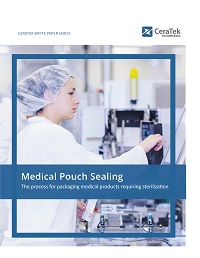A Guide to Medical Pouch Sealing

What is a Medical Pouch Sealing?

A medical pouch is a flexible package consisting of laminated or mono-layer flexible materials including but not limited to Tyvek®, coated foil, film, and coated paper. The pouch is created by bringing two webs of material together and sealing them on three sides, leaving the fourth side open. The product is inserted into the pouch and then it is heat sealed across the fourth and final side to create a sealed package in preparation for sterilization.
The heat sealer used in this process must be a medical grade sealing system that provides accurate and repeatable control over temperature, pressure and seal time. In addition, the system should include process alarms and features to prevent the operator from modifying the validated settings, and the heat sealer should be ISO 11607 compliant, cleanroom compliant and able to be validated and calibrated.
Because medical packaging is so critical for keeping medical and life science products free from contamination, medical pouches are considered part of the product delivery system. When a medical device manufacturer is designing a package, they qualify the package along with the product because the product is not considered usable unless it can arrive at its ultimate destination as a sterile product. So, the sterile barrier system is the package, and in most cases, the package is part of the product, because the product cannot be used without proper packaging.
Medical pouch sealing is used for a variety of items that need to be kept sterile
Manufacturers use medical pouches to package a wide range of high value products used in health care and the life sciences. For example, medical pouches are used to package single use disposable devices, such as catheter delivery systems. . In addition, medical pouches can be used for devices that ultimately become a permanent part of a patient’s anatomy, such as stents, the components used for hip replacements and the screws and rods that can be used to repair bone fractures. Medical pouches are also used for packaging certain surgical instruments, although in many of these cases, the instrument is cleaned/reprocessed, sterilized, and packaged more than once.
Typically, medical pouches are not used for lower value medical products, such as gauze or bandages. They are used mostly to package medium or high value, low volume medical products.
[Take it with you. Download the Guide to Understanding Medical Pouch Sealers]
The Different Types of Medical Pouch Sealers

Constant heat sealers
A constant heat sealer is typically a “jaw type” sealer, with seal dies that repeatedly open and close, sealing one pouch at a time. A constant heat sealer has a heater embedded into its aluminum sealing die. The operator turns the machine on and selects the appropriate recipe. After a short period of time (approx. 10 minutes), the die is heated to the set temperature and the heat is evenly distributed across the sealing die, and the die will remain at this temperature until the sealer is turned off or a different temperature is selected. Because the die is heated to one temperature and it remains at that temperature until either the set point is changed or the machine is powered OFF, constant heat sealers are the easiest heat sealers to validate. They also provide the most stable, repeatable sealing process and require less ongoing maintenance than other types of sealers.
For these reasons, constant heat technology is the preference of most medical device manufacturers. Typically, constant heat technology is used to seal the three sides of the pouch when it is made —and so, it is the technology that will provide the best, most compatible seal across the final, or fourth, side of the pouch.
Impulse heat sealers
Like constant heat sealers, impulse heat sealers are usually also “jaw type” sealers; however, the heating element of an impulse heat sealer is a very thin wire that can heat up and cool down quickly. As a result, after an “impulse” of heat is generated, the die rapidly reaches temperature and then cools down, all while under pressure. The operator can keep the die closed as the heating element cools and the pouch material drops below the melt point to a temperature that allows the pouch to be removed from the sealer and handled without worries about it being tacky or damaging the seal.
Impulse heat sealers are typically used for either the high temperature sealing or welding of mono-layer materials. They are not preferred when sealing pouches made from multi-layer materials because when the temperature fluctuates between heating and cooling every cycle, it is difficult to maintain accurate process control.
The most common method for monitoring the fluctuating seal temperature on impulse heat sealer is with a thermocouple, which measures the temperature and sends that signal back to the temperature controller. Impulse sealers require very fine thermocouples because the finer the thermocouple, the faster the response. (which means they are likely to need frequent replacement). Note: Every time maintenance is required on a medical grade heat sealer to replace a critical component that is part of either the temperature delivery, pressure delivery, or the time delivery system, the sealer needs to be re-qualified.
Rotary band or continuous band heat sealers
A rotary band or continuous band heat sealer is not a “jaw type” sealer that seals one pouch at a time. Instead, a continuous band or rotary band heat sealer uses opposing bands to carry pouches through the heat sealing process. The operator feeds the leading edge of the pouch into the sealer, where it is captured by the bands and pulled through to the section where heat is applied. The heat brings the materials to the melt point and welds them together, and then the bands continues to pull the pouch through the sealer to an unheated section where cooling occurs. The cooled pouch then emerges from the other end of the machine.
The advantage of a continuous band or a rotary band heat sealer is throughput. It offers significantly higher output compared with a jaw type heat sealer. In addition, a continuous band sealer is optimal when the two sides of the pouch are the same material (similar materials have the same thermal expansion rate and dissimilar materials can expand at different rates which can result in wrinkles in the seal). Rotary band sealers are also optimal for products that are light weight, flat, and lower profile. Rotary band sealers can operate in a horizontal or vertical orientation.
Interestingly, a continuous band or a rotary band heat sealer offers the benefits of both constant and impulse heat. The actual pouch sealing is done with constant heat, which is a very stable temperature, but then the pouch is pulled along to an area where there is no heat, enabling it to cool under pressure.
Form fill seal heat sealers (F/F/S)
A form/fill/seal machine does not use preformed pouches. Instead, it uses two rolls of material that come together in the middle of the machine to actually create the pouch around the product. The operator places the product, either manually by using automation, into the sealer and then the sealer uses a set of reciprocating dies to create a sealed pouch around it. Form/fill/seal machines can be horizontal of vertical.
Form fill seal machines are used for high throughput, high output requirements. In fact, they can usually run as high as 20 plus cycles a minute. However, tool change overs for form fill seal heat machines can be time-consuming because in these instances, seal dies and cutting mechanisms need to be replaced. By contrast, with a traditional impulse sealer, constant heat sealer, or rotary band sealer that uses a preformed pouch, there are no full-on changeovers, enabling operators to move easily and quickly from one type of pouch to another.
For any of these heat sealers to be used for medical pouch sealing, they should be ISO 11607-compliant. ISO 11607 is a guidance document that is used to define many different aspects of sterile packaging. For example, for a piece of sealing equipment to be ISO 11607-compliant, it must have the ability to verify and alarm temperature, pressure, and time.
[Take it with you. Download the Guide to Understanding Medical Pouch Sealers]
The Materials Used to Make Medical Pouches

Tyvek® and film is the most common material combination used for medical pouches. Tyvek® is made of 100% high density polyethylene fibers, and it is manufactured to be “breathable,” and yet impervious to microbes. Often, medical pouches are made from Tyvek® on one side and another material on the other side.
The characteristics of the product being packaged can impact what type of material should be used for the medical pouch. For instance, if a manufacturer is packaging bulky product that could potentially put a strain on the inside of the pouch, it may be optimal to use a pouch made from a linear low-density material that is elastic and puncture resistant. If it is human bone or tissue that needs to be packaged for transplant purposes, the medical pouch is likely to be made from Polytetrafluoroethylene (PTFE) or Teflon, materials that can withstand the cryogenic conditions required for transportation.
Medical device packaging occurs in clean rooms
Typically, medical device packaging happens in either a class 10,000 clean room (ISO class 7) or a class 100,000 clean room (ISO class 8). The numbers 10,000 and 100,000 refers to how many parts per million of particulate are allowed to be in the clean room atmosphere.
The ISO classifications for clean rooms should not be confused with the ISO designation for sterile packaging. ISO 11607 is a guidance document that is used to define many different aspects of sterile packaging. For example, for a piece of sealing equipment to be ISO 11607-compliant, it must have the ability to verify and alarm temperature, pressure, and time.
How products in medical pouches are sterilized
The products that are packaged in medical pouches are not sterilized beforehand. Instead, they are sterilized post-packaging, using either ethylene oxide (EtO) sterilization, electron beam (e-beam) sterilization, radiation sterilization or steam sterilization.
EtO sterilization
EtO sterilization is the procedure most commonly used to sterilize medical products packaged in pouches; however, it does require that at least one side of the pouch be made from a breathable material, such as Tyvek®. Generally speaking, here’s how EtO sterilization works:
After the product is sealed into a medical pouch, the pouches are packaged in boxes and cartons, palletized and sent to a sterilization facility (the entire pallet of products can be moved into a sterilization chamber all at once). Then, ethylene oxide (EtO) gas is pumped into the chamber under pressure.
In the case of a medical pouch made of Tyvek®, the EtO gas passes through the Tyvek® material, killing any contaminating microorganisms that are inside the package. Then, the pressure is relieved, as regular air is pumped back into the chamber, dispersing the EtO gas. As long as the package remains sealed and dry , the contents should remain sterile for the shelf life of the package.
Many medical products are packaged in linear, low density materials with a small Tyvek® window, or header, on one end of the pouch. These “header bags” can reduce costs, but because of the Tyvek® window, the products within them can still be sterilized using EtO sterilization.
Electron beam (e-beam) sterilization and radiation sterilization
Unlike the EtO sterilization process, electron beam (e-beam) sterilization and radiation sterilization do not require medical pouches made from breathable material. Typically, these types of sterilization processes are used for medical pouches consisting of non-breathable films or coated foils. As the names imply, e-beam sterilization uses electron beams to sterilize the medical product after packaging, and radiation sterilization uses radiation, usually in the form of high energy gamma rays.
Steam sterilization
Steam sterilization, as accomplished in an autoclave, exposes each item to direct steam contact at the required temperature and pressure for the specified time. There are four parameters of steam sterilization: steam, pressure, temperature, and time. Typically, Tyvek/film pouches are used for this application but the pouch is specifically designed to withstand the sterilization process. Typically, steam sterilizable pouches have a higher sealing temperature and a narrower processing window than pouches used for ETO sterilization.
[Take it with you. Download the Guide to Understanding Medical Pouch Sealers]
How to Optimize Heat Sealers

Heat seals are created by delivering a specific temperature, under a specific pressure, for a specific amount of time. When designing a package and defining its optimal sealing parameters, manufacturers run a DOE (Design of Experiments) to determine what the low and high points are for temperature, pressure, and dwell time.
Then, they use this data to create a 3D matrix, where the center point marks the optimal temperature, pressure, and time. They also identify a process that has a range above and below the temperature set point, time set point, and pressure set point, where an acceptable, although not optimal, seal can still be achieved. This creates a window for alarming around the optimal seal parameters where the heat sealer can operate.
The more consistent a heat sealer is in delivery of temperature, pressure, and time, the more repeatable the seal strength will be—and the more repeatable the seal strength is, the tighter the manufacturer’s statistical control over that packaging process. Tight statistical control is important. If a manufacturer has to defend their packaging process during an FDA audit, tight statistical control will give the FDA more confidence in the development of the packaging process.
Manufacturers need to validate their heat sealers to verify that they deliver the same seals in a repeatable manner cycle, after cycle, after cycle. These processes must be minimally affected by operators, and they need to deliver the designated temperature, pressure, and dwell time repeatedly and reliably.
How to measure medical pouch heat seal integrity
There are a few different ways to verify seal integrity and quality. The most common way is to measure peel strength using a tensile tester. This process involves clamping a sample of the seal into the two plates/grippers of a tensile tester, and then measuring the force required to separate the seal. The goal is to achieve a repeatable seal strength, so this test will typically be conducted multiple times. Another way to test seal integrity is to use a burst test, where the inside of the pouch is increasingly pressurized until it bursts and/or the sterility is compromised. Medical device manufacturers use a Process Capability Index called CpK, to describe how accurate and repeatable the seal strength is over the course of a sample lot.
Recently, the FDA has begun to focus more than ever before on the statistical control that medical device manufacturers have on their processes. This means medical device companies are being driven to have a higher process capability, or Cpk. CpK indicates how accurately a medical device manufacturer can control medical pouch seal strength, and how repeatable their processes are. It is imperative for medical device manufacturers to identify the sources of variability in their heat seal processes, and then control those variables with precise and reliable systems for temperature, pressure, and timing.
Different heat sealers run differently. For example, in an impulse sealer, heat can build up in the bar that supports the wire, and that can change the amount of heat that packages is exposed to over the course of a production run. This type of variability can result in peel strengths that change throughout the production run. This is one of the reasons why it is more difficult to achieve a high CpK with an impulse sealer compared to a constant heat sealer. With a constant heat sealer, the seal heat is stable, leading to a high CpK.
Keep in mind that temperature, pressure, and dwell time are all interrelated. Of these, the two most critical factors in seal strength are temperature and dwell time. Pressure is the least impactful, because once intimate contact is achieved, increasing seal force, or seal pressure, will not have a big impact until the pressure level increases to the point of squeezing the adhesive layer out of the seal. So seal force is the least impactful, once you’ve achieved intimate contact.
Throughput objectives can be a factor, as well. If a medical device manufacturer wants to maximize throughput, they may increase temperature and decrease dwell time, because they want to get more medical pouches sealed faster. Another manufacturer may want more process stability, and so they may opt for a lower temperature with a longer seal time. The ultimate goal of either throughput or stability will drive the sealing process toward low temperature with high time, or low time with high temperature.
[Take it with you. Download the Guide to Understanding Medical Pouch Sealers]
Validating Heat Sealers

Heat sealers must be validated before they can be used in production. This validation is a three-phase process.
The first phase is the IQ, which stands for installation qualification. During the IQ, the medical device manufacturer verifies that the heat sealer was built to spec, has the needed utilities, and was installed properly.
The second phase is the OQ, or operational qualification. For the OQ, the medical device manufacturer must walk through all the control processes of the heat sealer and verify that it operationally functions every time as it should. The temperature control, pressure control, time control, recipe control, alarms and all other operational aspects must be verified.
The final phase is process qualification, or PQ. The PQ phase involves observing the heat sealer in combination with the medical pouch it’s going to seal, i.e., the actual heat sealing process. The IQ and the OQ are focused on the heat sealer itself. The PQ phase verifies that the heat sealer is delivering a repeatable process and that the medical pouch is sealing in a repeatable fashion. It confirms that the output is what it’s supposed to be.
Any heat sealer used for medical pouch sealing should be ISO 11607-compliant. ISO 11607 is a guidance document that is used to define many different aspects of sterile packaging. For example, for a piece of sealing equipment to be ISO 11607-compliant, it must have the ability to verify and alarm temperature, pressure, and time.
FDA approval of medical pouches
Just as medical products require FDA approval, medical packaging must also be FDA approved. Medical device manufacturers need to have their manufacturing and packaging processes regularly audited to ensure that they are using the proper equipment and that it has been validated and maintained properly. The FDA offers approval guidelines for medical manufacturers to follow, but it does not provide instructions.
The types of heat sealer options
Today’s heat sealers can come equipped with options that help with compliance and risk mitigation. Traditionally, medical pouch sealing has been mostly a manual operation. However, more and more medical device manufacturers are implementing automation and other features to minimize operator error and mitigate other risks.
For example, some heat sealers are not enabled to cycle until the product which is put into the package is confirmed by weight. Others are equipped with barcode readers, vision cameras, or other sensors that detect certain markings on a pouch to verify that it has been positioned correctly for sealing. The cycle will only begin if the medical pouch is properly oriented and located. In some cases, heat sealers come equipped with alarms to alert the operator of errors and that a pouch needs to be put into a quarantine bin before the next cycle can start. They can also have outputs designed to control conveyors that move a pouch to the next process based on whether or not there was a good or a bad cycle.
Features for printing are also becoming more popular. For example, inkjet printers or embossing type systems can be added to continuous band or a rotary band sealers so that the medical pouches are printed on as they are sealed. Embossers can also be added to jaw type heat sealers to emboss a fixed imprint into the pouch.
In addition, other ancillary equipment can be added to heat sealers to help operators work more efficiently. For instance, some heat sealers have a pouch opening system that will pull a pouch out of a magazine and present it to the operator in an open format. After the operator places the product into the pouch, the pouch opener releases the package so that the operator can seal it. Since operators working in a clean room are typically gloved, this type of pouch opening system can significantly increase throughput. Efficiency can also be improved using static elimination options, which range from an overhead ionizing fan blowing down on the assembly area to reduce the static field to static elimination chambers for the medical pouches to pass through.
[Take it with you. Download the Guide to Understanding Medical Pouch Sealers]
How to Select a Vendor for Heat sealers for Medical Pouches

First, it’s important to find a heat sealer vendor that has the ability to customize their equipment to meet your specific medical pouch sealing needs. Look for a company that can handle the design engineering in house so that they can tailor a solution to fit your production flow.
Second, it’s critical for you to find a heat sealer vendor that understands the industry requirements of validation and package testing. They should also be involved at the industry level through ASTM, AAMI, and other organizations such as the IoPP medical packaging subcommittee. The vendor you choose needs to understand not only where the industry is today, but also where it’s going, so that you can rest assured that you are getting the most up to date technology to meet your needs.
Third, look for a heat sealer vendor that has a strong field service engineering team. They need to be able to handle both remote and on-site service support, regardless of where your packaging operations are located throughout the world. Look for a vendor that will partner with you as your equipment supplier, complete with a field service engineering network that offers rapid support for all your medical pouch heat sealing needs.
[Take it with you. Download the Guide to Understanding Medical Pouch Sealers]


